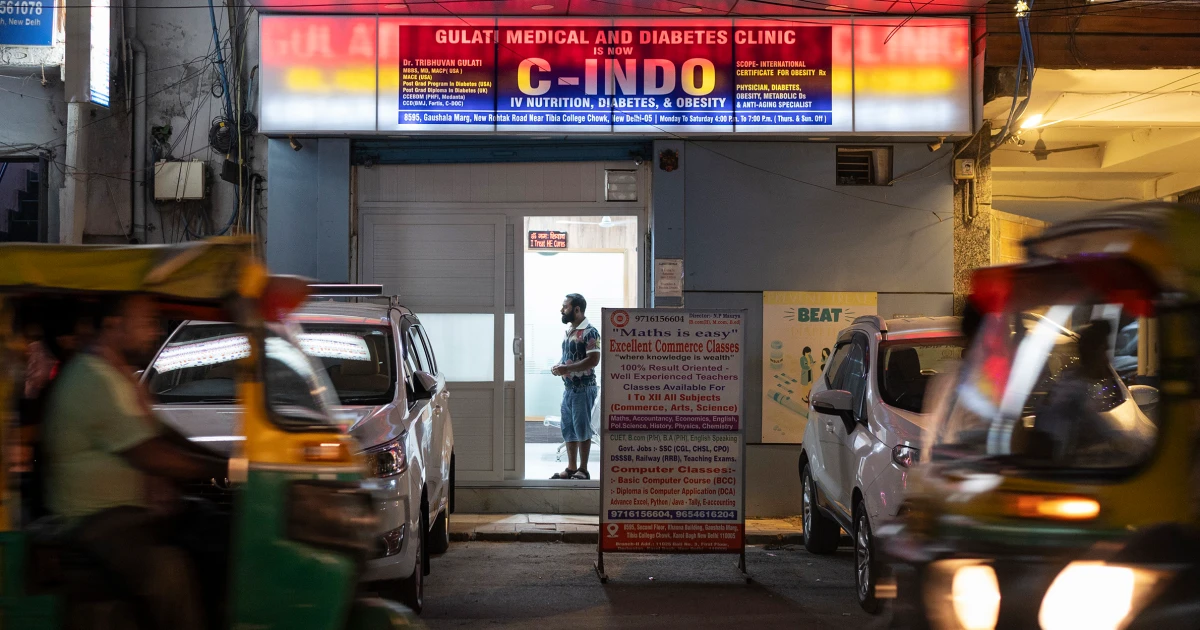Copyright NBC News

NEW DELHI — When the weight loss drug Mounjaro came on the market in India earlier this year, Shyamanthak Kiran was one of the first patients to try it. Kiran, a 27-year-old financial trader who has struggled with hypothyroidism, said he “did not have a lot of expectations” when it came to losing weight. But “luck turned out in my favor,” he said, and in six months he lost all of the 60-plus pounds he had gained a few years earlier. “It was a two-year struggle that came to an end, and I couldn’t be happier,” he told NBC News. Indians trying to lose weight are embracing drugs such as Mounjaro, which is also used to treat diabetes in a country that has been called the world’s diabetes capital. The injectable medication from American pharmaceutical company Eli Lilly has become India’s most popular drug by value since being approved in March, with over $11 million in sales in October, pharmaceutical market research firm Pharmarack said Friday. Even before India’s more recent approval of Ozempic, another drug that is widely used for weight loss in the United States and other countries, there was already surging demand in the country for semaglutide, its active ingredient. Ozempic’s Danish drugmaker, Novo Nordisk, says it is “actively working” to widen the availability of the drug, which Indian regulators have approved for diabetes but not obesity. The company also makes other semaglutide drugs that are already used for weight loss in India, including Wegovy, an injectable, and Rybelsus, which is taken orally. Demand could grow even further when the patent for Ozempic’s active ingredient, semaglutide, expires next March in India, a pharmaceutical manufacturing giant where companies are eager to produce cheaper generic versions of the lucrative weight-loss drugs. The exploding popularity of the drugs has alarmed some doctors and officials, with Jitendra Singh, a government minister and physician, warning in August against the “unchecked spread of disinformation” through “fad regimens” and emphasizing the importance of lifestyle interventions such as regular yoga practice. Semaglutide and tirzepatide, the active ingredient in Mounjaro, are GLP-1 agonists that were first developed to treat diabetes and have also been approved in many countries for the treatment of obesity. They regulate blood sugar and help slow how quickly food passes through the stomach, curbing hunger as a result. India, the world’s most populous country, has over 100 million people with diabetes, or nearly 10% of its adult population, according to a 2023 study by the Indian Council of Medical Research. An additional 135 million people are prediabetic, the study found. Doctors say the situation is worsening as India’s burgeoning middle class adopts a more Western lifestyle, eating more high-fat, high-sugar foods and exercising less. “Compared to, say, a decade ago, there are more people now in their late 20s and early 30s who are being diagnosed with diabetes, as compared to the elderly population,” said Dr. Saurav Shishir Agrawal, an endocrinologist in Noida, which is part of Delhi’s capital region. “They ask us to just give them pills,” Agrawal said, “but these medicines work better only when you are clubbing them with lifestyle changes.” Agrawal practices at the newly built Medanta Hospital, where staff greet patients with a gentle “Namaste.” It is an example of the growing number of modern and high-end hospitals popping up around increasingly dense megacities such as Delhi, home to 33 million people, where diabetes has a greater hold. A monthly course of Mounjaro can cost as much as $250, the average monthly salary in many parts of India. But for more affluent Indians, a bigger deterrent is the idea of injecting themselves, said Dr. Tribhuvan Gulati, an endocrinologist. “People get scared whenever you tell them that they’re going to be on an injectable,” said Gulati, who has a clinic in central Delhi. Gulati keeps a demo pen of Mounjaro in a drawer to show how easy it is to use the medicine, which just needs to be refrigerated before use. But the ease of use is also what worries Gulati and other doctors, who say many patients fail to overhaul the lifestyle and dietary habits causing or contributing to their health issues in the first place. “If you look at the causes of obesity in India, it is 90% lifestyle and 10% anything else,” said Dr. Anoop Misra, chairman of the Fortis Centre for Diabetes, Obesity and Cholesterol and head of India’s National Diabetes Obesity and Cholesterol Foundation. “The diet now is totally imbalanced because of free availability of food everywhere,” he said. The potential gastrointestinal and other side effects from the weight-loss drugs, which in the U.S. have prompted multiple lawsuits against GLP-1 makers, give some patients pause, Gulati said. But others “are OK with continuing it throughout their life because they know that they won’t be able to control themselves.” Diabetic patients such as Moinak Pal, who has high insulin resistance, say that GLP-1 drugs have been the easiest way to lose weight. “I have been fat-shamed since I was a child,” said Pal, 34, a Noida-based journalist. He said he has been losing about 3 pounds a week since he started taking Mounjaro. It was “extremely difficult for me to lose weight by conventional means,” he said. Part of the problem, Misra said, is the lifestyle in India’s sprawling and congested urban areas, where commutes can last as long as four hours round-trip. When workers get home, apps can deliver everything from food to clothes to their doorsteps in minutes. “They want quick fixes that don’t involve going on a restrictive diet or daily exercise of an hour and so on,” he said of some of his patients. “As a result, diabetes is everywhere. Every day I see patients who are young, who have uncontrolled Type 2 diabetes.” Rajendra Nath Dixit blames nobody but himself for his health problems. The retired banker had heart bypass surgery earlier this year, and before that had been spending almost 8,000 rupees ($90) a month just on his insulin. “I was fond of taking the typical Indian oily foods, samosas, chole bhature, and in the evening I would take five or six rotis,” said Dixit, 66. “Every bad habit was there.” In the five months since his surgery, Dixit has switched over completely to the oral semaglutide Rybelsus, is exercising more and is consuming less fat and sugar. He is spending 11,000 rupees ($125) a month on Rybelsus, but has been able to stop using insulin. “I’m feeling very good, very light,” he said. “My confidence has gone up, and my life has totally changed.”



